Results of 2022 Patch Monitoring Project
Suhel Quader made an eBird checklist almost every school day, from January 2014 to December 2019, while he walked his children to their bus stop. He analysed the data to come up with this beautiful representation of the status of his neighbourhood birds.
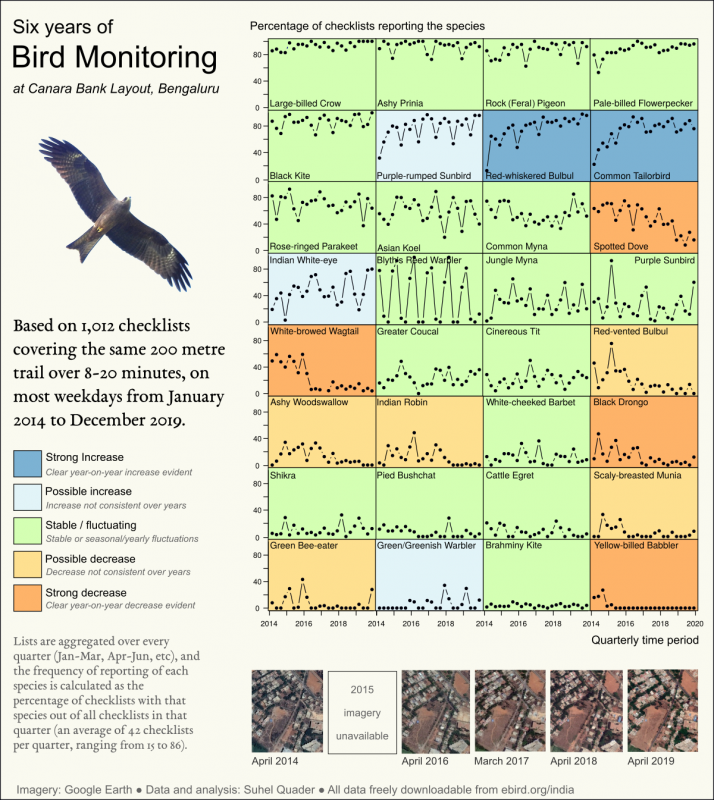
These wonderful insights were made possible just from simple, regular, systematic monitoring of his everyday patch! Simple, fairly consistent bird listing can yield interesting insights into the birdlife around one’s neighbourhood. If a large number of bird watchers across India upload eBird lists consistently from the same location, this can form a supplemental bird monitoring scheme for the country.
If you have a patch that you are monitoring already, or if you think that you can regularly monitor a site that you visit, join in for a more systematic approach to bird monitoring!
Read this article carefully and register your patch to participate in our first systematic national patch monitoring effort!
Click here to watch the webinar recording conducted on July 18th for the registered participants.
So, let’s start systematically monitoring our patches today!
Project start
July 2021
Selecting a patch
Select a small patch that you would like to monitor. Your patch can be anything from a wetland, a forest or a scrubland, or even your local built-up neighbourhood in the city as in Suhel’s example!
Once you select a patch, fix a single track that you want to monitor.
Monitoring protocol
- Visit your patch at least twice a month*, between dawn and 10AM, or between 3:30PM and dusk (in the first and third week, or the second and fourth week of the month). Please ensure that you monitor your patch either in the morning or in the evening, and not interchangeably.
- Use either of the following methods to create your eBird list(s) based on whether your patch is a terrestrial patch (wooded area, cultivation, scrub) or a wetland patch:
-
- Terrestrial patch: Time based listing along a track – walk along the track and make at least four 15-min eBird lists. You can do more than four, but keep it consistent from one visit to the next.
- Wetland patch: Total count along a track – Most suitable for small to medium-sized wetlands. Walk along your chosen track (which may cover all or part of the wetland), and make a single list with all species and their counts.
- List all the birds as and when you see and/or hear them and create complete checklists in eBird App.
- DO NOT assign checklists to a hotspot, but create a NEW personal location for each habitat to which you always assign the lists made in that habitat.
- Create only a single personal location for a Wetland patch but one for each habitat in a Terrestrial patch.
- Name each personal location using this format “location name–wetland or terrestrial–habitat type–PMP”. If your patch is called “Jakkur Lake” which is a wetland, the personal location name should be “Jakkur Lake–wetland–PMP”. You can skip the habitat type for wetlands. If your patch is called “GKVK Campus” where you want to monitor a trail with three habitats 1) cultivation 2) thorny scrub 3) mixed, you can create three personal locations 1) “GKVK Campus–terrestrial–cultivation–PMP” 2) “GKVK Campus–terrestrial–thorny scrub–PMP” 3) “GKVK Campus–terrestrial–mixed–PMP”.
- Add comment “Patch monitoring” and share it with patchmonitoringindia eBird id.
*If you miss a fortnightly visit, don’t be disheartened, continue the monitoring from the next possible day.
(Scroll down to see FAQ’s)
Uploading your lists:
Use the eBird mobile app for entering your lists while you are birding. If you are not familiar with the eBird app, you can find details on how to get started with the app here. We suggest that you upload your checklist the same day as you do your birding as the details will be fresh in your mind. Please make sure that the ‘record track’ is ON while you are birding. All tracks can be subsequently downloaded as KMLs – https://www.faintlake.com/eBird/GPStrack/
During the breeding season (Mar- Sept) use the breeding codes to document all signs and stages of breeding.
All the eBird lists uploaded for this project will undergo the regular reviewing process. You can find the details of the review process in eBird here.
Leaderboard:
The patch monitoring leaderboard page on the BCI website will display the names of the birders with the top 20 longest monitoring streaks and the 20 birders who have monitored their patches on the most occasions.
Register your patch:
Now that you have read the article, register your patch or patches by filling this form. If you want to register multiple patches, submit one registration form for each patch.
Other helpful information
Identifying birds
Identifying birds is crucial for any bird project. While most of you may be familiar with the birds in your selected patch, we recommend that you go through eBird lists from the nearby eBird locations/ hotspots and acquaint yourself with the birds seen in that area. Other than a good field guide, also download Merlin Bird Id– a free app by The Cornell Lab of Ornithology that can aid in identifying the most common birds. Here is more about Merlin- http://merlin.allaboutbirds.org/; check out this article for some more details. Having said that, there would always be some birds that are tricky to identify, like warblers, pipits, and larks. This detailed article will give you a better understanding on how to document species that are difficult to identify. Check out this article on digital tools.
Can’t Identify Species?
If you are not sure about what pipit or lark you saw, use pipit sp., lark sp.,. If you are sure you saw a leaf warbler use phylloscopus sp.. Here is a useful link to understand how to enter non-species taxa. In case you could not identify the species at all please document it as ‘bird sp.’ and the count. In such cases, a quick sketch or a photograph, or recording the call on your phone/ camera might get you some help in identification.
Counting large numbers
If your site is a wetland or farmland, it is possible that you might see birds in large numbers, especially during winters when many migrants arrive. Here are some links that can guide you on how to count large flocks or mixed flock: https://ebird.org/news/counting-101/ and https://ebird.org/news/counting-201/
All Counts matter
The aim of the patch monitoring project is to count all the birds that you see in your patch. Regardless of whether you see the same birds every week, or you see very few birds or no birds, your counts are valuable and important. Remember, the most reliable information necessary to understand what’s happening in your site is coming from your observations.
Count all birds
Every bird that is identified, by sight or by sound, should be counted. If there are birds which simply flyover your site, such as a pod of pelicans or flocks of parakeets going to roost, please make sure that you enter the “Flyover” breeding code without fail. You can read more about the Flyover code here. This is extremely important as the survey’s aim is to document the birds at your site and by using the Flyover code you will document all the birds you see and yet the flyover birds can be eliminated from any analysis.
However, if you do see birds circling above your site then they should be counted and added to your list. For example, a bird of prey circling above your site could mean it is possibly scanning for a prey, or a pair of Woolly-necked Storks circling above your site could mean that they want to land near the water body present at your site.
Breeding codes
Enter breeding codes for all birds where breeding evidence is visible. You can learn all the breeding codes here and here.
There are quite a few Quick Guide Videos and Webinar Recordings about eBird features available on Bird Count India’s YouTube Channel.
Important Note: While birding, please ensure that you adhere to COVID-19 related instructions by central and local authorities.
FAQs
1) What is the difference between patch monitoring and patch birding?
Patch monitoring is patch birding with standard and strict protocols. During regular patch birding, you may walk in a forest habitat for 30 mins while making a checklist on a certain day, but you may walk for 45 mins on another day. Such checklists become difficult to compare due to variable birding ‘effort’. In patch monitoring, you ensure that the ‘effort’ remains the same and therefore only make 15-minute lists. In a wetland, the effort for patch monitoring is to remain the same not with constant duration but with how much ever time it takes to do a complete count of your track.
2) Why should I make a single list for the wetland patch?
Birds in wetlands are usually easily visible unlike in terrestrial habitats. So while repeated 15 min checklists keep producing different sets of species in terrestrial habitats, repeated 15 min counts in wetlands are likely to produce the same set of waterbirds. Therefore, to monitor a wetland habitat, you will need to do a complete count of the waterbirds each time. The time taken to count and identify all waterbirds may be different each time based on the number of waterbirds present and how far off they are. This is why we recommend a single checklist with a complete count of all waterbirds.
3) Why should I make multiple 15 min lists for a terrestrial patch?
Repeated 15 min checklists will allow you to calculate the frequency of reporting (or the commonness) of a species in your patch. In four checklists, you may see Common Myna in all four but Common Iora in only one list. This will indicate that Common Myna is more common than Common Iora. With multiple sets of checklists every week or two weeks, the commonness of a species can be tracked over the seasons. And eventually over years which has considerable conservation significance!
4) Why should I monitor my patch consistently during the same time of the day?
If you have decided to make morning checklists, ensure that you ALWAYS monitor your patch in the morning. Same applies for the evening lists. If you make a morning checklist one week and an evening checklist during the next, these become difficult to compare because bird activity is so different during these two periods.
5) Can I upload 2 checklists in the morning and 2 in the evening?
Yes, as long as you continue the same during the entire monitoring period.
6) Why should I upload these checklists to a personal location and not to a hotspot?
Your personal location is only for your patch monitoring checklists! Any other eBird checklists that you make can be uploaded to a hotspot or any other personal location. This is because that single location will contain only information about your patch monitoring, and not about anything else. Additionally, hotspots can be used by multiple people and therefore your patch summaries will also include checklists by other people.
But if you want your patch monitoring checklists to also become a part of the hotspot, you have a simple fix. Upload your checklist to the personal location and then share it with the ‘patchmonitoringindia’ eBird ID. Once the checklist is successfully shared, you can change the location of your own checklist to the hotspot. You therefore ensure that the PMP checklist remains in the appropriate personal location.
7) Can I use the stationary protocol for patch monitoring?
Only if you are making rooftop, balcony, or backyard checklists, you can use the stationary protocol.
8) Why is stationary protocol not recommended for patch monitoring?
A traveling checklist is likely to give a better representation of an area because you are likely to cover multiple habitats, views and locations. The birds seen in your stationary checklist may be influenced by how much visibility you have from that point. So it is better to walk at least 100 to 200 m while making checklists.
9) My patch is small and can be completely surveyed in 15 mins. Should I then make four 15 min checklists?
You can make 4 checklists in the same trail, going back and forth. You will see that the birds you see are not exactly the same in every 15 min checklist and you will get data for calculating rate of reporting (explained earlier), which is very valuable.
10) What is the minimum size for a wetland patch?
There is no minimum size. Any wetland qualifies as long as it consistently holds wetland birds.
11) If I do not manage to get the monitoring done on the 14th day and do it on the 15th day, is it ok?
It is perfectly fine, as long as you keep the monitoring at APPROXIMATE weekly or fortnightly intervals.
12) You mention that the checklists must be made between dawn and 10AM, or between 3:30PM and dusk. What do I do if my birding site experiences a tidal cycle that influences daily bird abundances?
You will need to ensure that your monitoring coincides with the specified time intervals and a certain consistent tidal state. For example, if you are monitoring the site during/near low tide that occurs between dawn and 10AM, try and monitor the site during the same time window during/near low tide approximately two weeks later. You can also monitor the site during high tide or any other tidal state, but ensure that you keep this consistent!
13) Should I create real-time checklists with the track ON?
Yes, so that the distance traveled and time spent birding is automatically calculated.
14) Can I add media to my patch monitoring checklists?
Yes, you can add detailed notes, comments, media to your patch monitoring checklists just like you do with your regular eBird lists.
15) What is the minimum duration to participate in the project?
Although it is best to monitor a site for multiple years, 6 months or more is the minimum period you can consider.
16) If there are paths in my trail which are not accessible during certain seasons, what do I do?
If your trails/birding site are not accessible in every season, there is still great value in monitoring it regularly for some part of the year. So you can participate in the Patch Monitoring Project by monitoring seasonal trails/sites.
17) Can group accounts register for patch monitoring and multiple people monitor the same patch?
No. The detectability of the specific birds will be different for different people, and checklists will not be easily comparable if different people monitor the same patch. However, the same patch can be monitored by different people but these will be their individual projects with their individual personal locations.
18) Can I make a personal location at a hotspot?
Yes.
19) Who should I contact if I have any more questions?
You can write to us at skimmer@birdcount.in
Banner Image: By Dhananjai Mohan, of one of his birding patches.

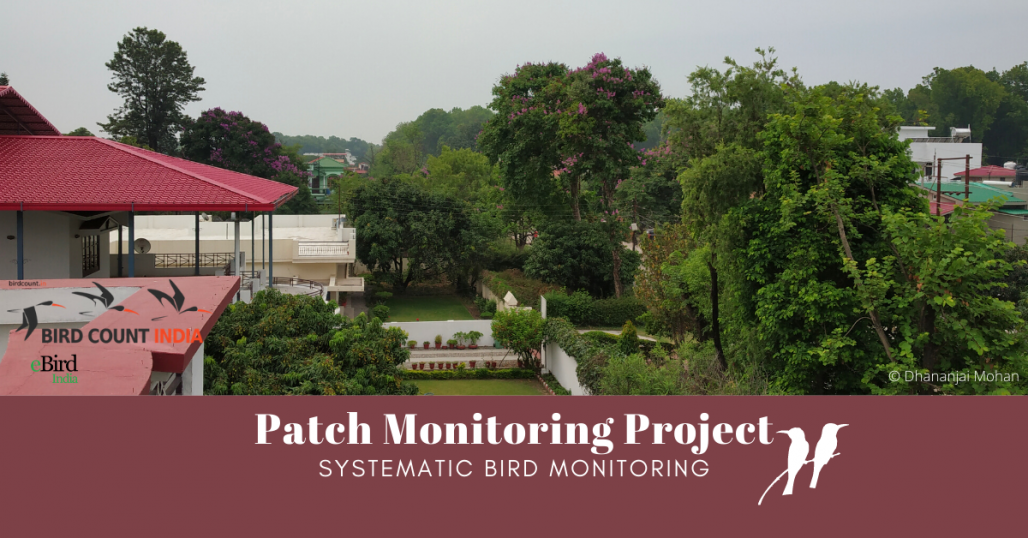
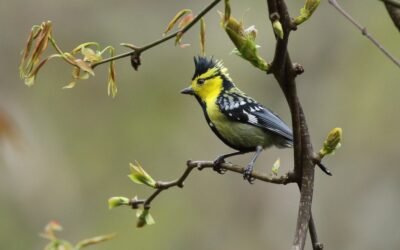
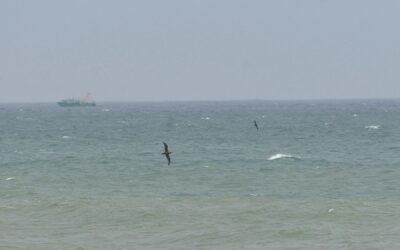
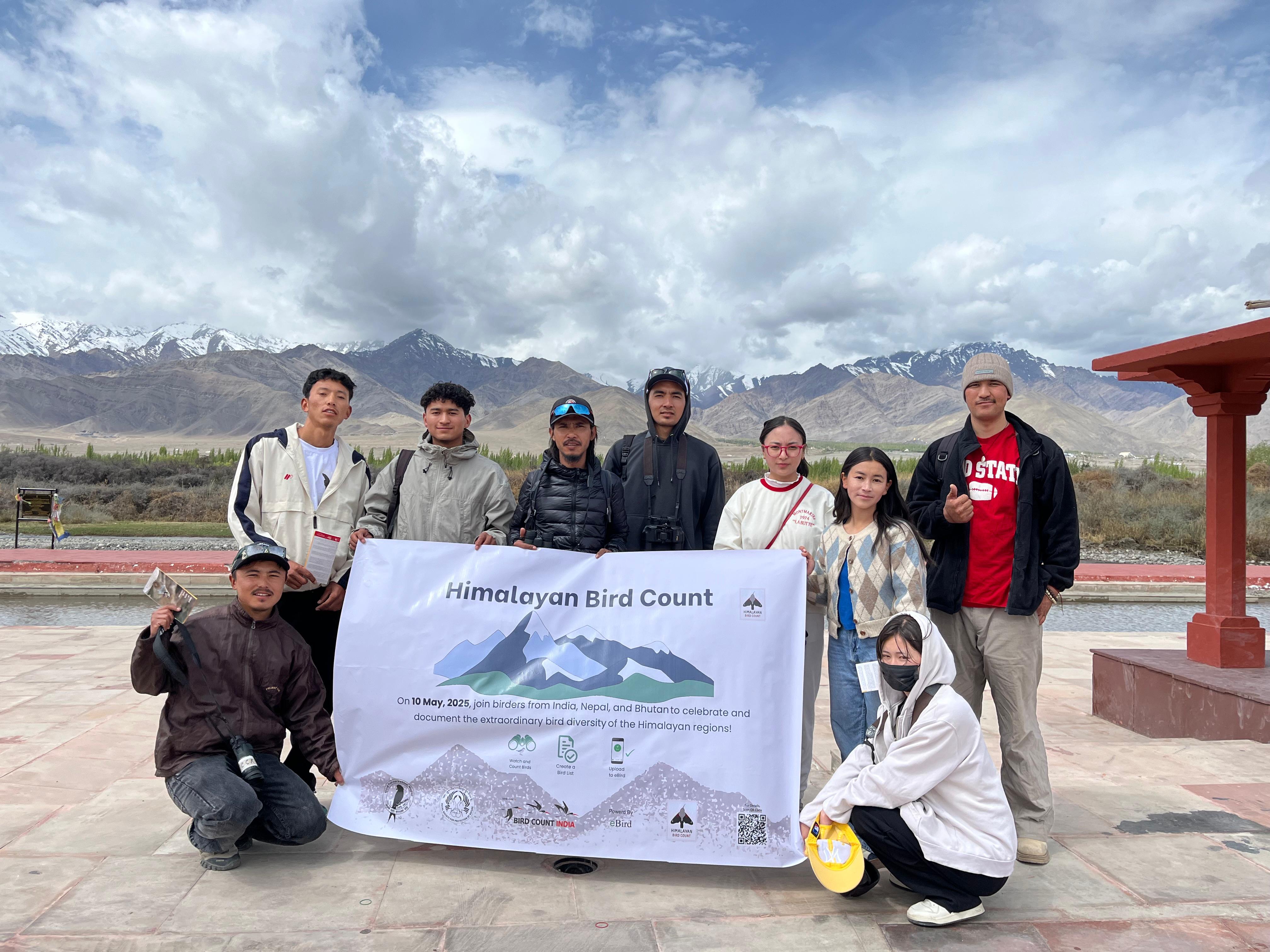
I was in search of this Idea very much.last year, I recorded on,eBird app practically two three times every month. Ramnagar, Bavdhan is my location. I registered all the names with Merlin app.I can join this group.
Hi Sushma, for this project, one has to be familiar with eBird Mobile App. You can write to us at skimmer@birdcount.in if you need further help.
Please allow some evening lists as well, this may help some evening birding people like me
You can make evening checklists but do ensure that you ALWAYS monitor your patch in the evening. Please see the monitoring protocols and FAQ’s for more details.
Are registrations for patch still open? I’ll be moving out of my location by end of Oct, can someone else continue with patch monitoring at the same patch?
Registrations for the patch are still open. We recommend that either you continue monitoring your old patch even after you have moved out or you can select a new patch closer to your new location.
I already have made a patch last year which contains a couple of locations accessible from my home. But as it is mentioned in the above protocol, the personal location should have a specific name. So can you help me how can I edit the names of my personal locations?
Hi Pranav,
Please watch this video to see how to rename a personal location- https://www.youtube.com/watch?v=HD2X4oKL5Nw
While renaming please ensure that you follow the format mentioned in the Monitoring Protocol of this article.
thanks for helping, will surely do that
As mentioned above, we should email the respective checklist to patch monitoring India email I’d. But I cannot see any email I’d here, so can you provide the email I’d of patch monitoring India?
It is mentioned above that you share your patch monitoring checklists with patch monitoring eBird user ID (not email ID) which is patchmonitoringindia
Can we monitor the patch during the morning hours as well as during evening hours on a regular basis?
Please watch this: https://www.youtube.com/watch?v=78d0J9XDO9w&list=PLzm9y1xekhiMssjQRTKFB4Wm4lUgGVS1f&index=8
Hello,
I kindly request you to update the status of patch monitoring programme.